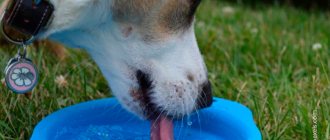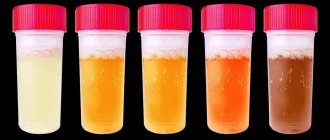Causes
What factors determine the disease?
If a dog constantly drips urine, the main causes of the condition are considered to be:
- Severe emotional stress caused by joy and fear. This phenomenon is understandable and acceptable in veterinary practice.
- Puddles in inappropriate places. Sometimes dogs want to deliberately harm their owner, so they start peeing where they are not allowed.
- Age-related changes - in an old dog, there is weakness in the bladder muscles. This phenomenon can cause incontinence.
- Congenital incontinence – dogs of any age can have pathologies of the genitourinary organs, which leads to urine leakage.
Natural
Urinary incontinence can occur for natural reasons, for example due to a psycho-emotional state.
An uncontrolled process does not always mean the development of a physiological problem in the pet’s body. Incontinence can occur due to the age of the animal and its psycho-emotional state. The natural causes of the process are considered:
- strong excitement - when incontinence is caused by stress, fear, pain or joy;
- designation of one's area, characteristic of male dogs;
- age-related changes;
- involuntary urination in bitches.
Diseases
The most common diseases include genitourinary tract infections and hypothermia. If the pet’s disease is diagnosed at a late stage, then it is accompanied by severe pain, as well as the appearance of blood in the urine. Antibiotics help eliminate cystitis or enuresis (urination during sleep) within a few days.
Note! Doctors carry out complex treatment, prescribing herbal preparations with diuretic and antiseptic properties to the pet.
Congenital physiological disorders - ectopia
Incontinence can occur due to ectopia.
This condition is characterized by a direct connection of the ureter to the urethra. As a result, involuntary urine leakage occurs. This is an almost uncontrollable process. If your dog is in heat, it's only a minor nuisance. As a rule, this disease is accompanied by serious illnesses:
- vaginitis;
- orchitis;
- epididymitis.
Weakness of urethral smooth muscle
An adult dog often experiences weakness of the smooth muscles of the urethra. The phenomenon is also uncontrollable, so you should contact your veterinarian as soon as possible.
Nervous breakdown
Another cause of incontinence is a nervous breakdown in a pet.
If your pet is frightened by something or has suffered a tragedy, he may have problems with urinary incontinence. With this phenomenon, the dog behaves extremely inappropriately, for example, symptoms such as:
- excitation;
- apathy.
Cystitis
Why does a dog have an inflamed bladder? This may be due to a malfunction of the urinary system. The most common disease is cystitis.
Important! There are factors that cause dogs to develop various types of illnesses, such as hypothermia and a poor immune system.
Urolithiasis disease
The cause of incontinence may be stones in the organs of the urinary system.
Often the cause of the formation of sand or stones in the organs of the urinary system is a bacterial or viral infection entering the dog's body. Irregularities in the pet’s diet also have an effect.
When an infection occurs, the disease is accompanied not only by incontinence, but also by pain. Sometimes you may notice:
- blood in urine;
- apathy,
- thirsty;
- lack of appetite.
Note! To cure a dog in a short period of time, experts prescribe anti-inflammatory drugs, antispasmodics and antibiotics.
Cystitis
The development of cystitis in a dog’s body is associated with the penetration of a bacterial infection or parasites. The spread of the disease can be particularly influenced by allergies, oncology, and kidney disease. The disease is accompanied by:
- pain when urinating (the animal begins to whine, sitting low);
- lack of appetite;
- the appearance of blood in the urine.
Important! After diagnosis, the veterinarian prescribes an antibiotic, antispasmodic or analgesic for the dog, depending on the severity of the disease.
Polydipsia
Polydipsia in a pet is a strong thirst.
The occurrence of polydipsia is associated not only with a pathological process, but also with a physiological cause. This disease can be triggered by excessive physical activity and high temperature (in summer). Polydipsia in dogs also occurs when following a certain diet.
Spinal injury
X-rays exclude urolithiasis and spinal injury. When the first symptoms appear, you should immediately consult a doctor. If treated incorrectly, complications may occur (bedsores, dermatitis).
The process of normal urination
Urine is formed in the renal corpuscles, accumulates in the renal pelvis, and then travels to the bladder. The process is continuous and repeats every 20 seconds. Fluid accumulates and does not flow out of the bladder, being held by the sphincter.
As soon as the signal from the brain passes, the pet’s sphincter relaxes and urine flows out of the bladder. The process is repeated again with new filling.
Why does my dog have urinary incontinence?
Urinary incontinence in pets can occur due to several reasons. True incontinence. This is a situation where there is constant leakage or involuntary discharge.
- Emotional stress. With strong emotions (joy, fear), the animal makes a puddle.
- Natural uncleanliness. The dog was not trained in time and was not raised properly, so it simply does not know how to ask to go to the toilet correctly.
- Marker of nearby territory. This is inherent in nature and often animals that are not sterilized mark the space around them.
- Incontinence associated with aging animals. His reflexes are weakened.
- Intentional urination indoors. It is done to spite the owner for its own reasons, in order to annoy its owner.
- Urinary incontinence as a sign of pathology
Uncontrolled urination in dogs can be a sign of inflammation. It is imperative to use diagnostics to identify the causes of the disease. But the prerequisites for this phenomenon are difficult to identify, and even diagnosis occurs by exclusion.
In order to correctly diagnose the disease, you should explain to the doctor all the features of the dog’s diet, nutrition, and the events that happened to it. The more information the owner provides, the easier it will be to understand this pathology or temporary condition of the animal.
We recommend reading: Impetigo on the Skin of a Dog, Purulent Sores Treatment
Cystitis
To identify it, it is necessary to submit the animal’s urine for analysis. Often the cause of urine leakage is cystitis. If the inflammatory process is very strong, then the dog may have urinary incontinence during sleep.
Cystitis is caused by two main factors: severe cooling of the body and infection of the genitourinary system. It should be treated with a course of antibiotics; a noticeable improvement occurs on the 4th day after taking the medication. If there is no treatment, then urination begins with an admixture of blood, the dog whines in pain, and difficulties arise in excreting urine.
Advice : You should not drown out the symptoms by taking several tablets; you must complete the entire course of treatment.
If the inflammatory process is not completely cured, the disease returns in 60% of cases, and a repeated course of antibiotics does not give a good effective result.
Polydipsia
Due to constant thirst, the animal exceeds the amount of fluid consumed. In female dogs, this is a symptom in which the owner should urgently take the pet for an ultrasound. If treatment is not timely, the uterus may need to be removed. Do not self-medicate; take your dog to the veterinarian to prescribe treatment for your pet. Constant thirst in a dog often indicates the development of diabetes mellitus, serious problems with genitourinary function and blood vessels, and kidney problems.
Spinal injury
Urinary incontinence can occur due to pinched nerve fibers or spinal cord injury. The pain is poorly controlled and incontinence often depends on the anatomical structure of the dog. Dachshunds and other breeds with long spines often experience problems with bowel movements and incontinence after injury. This predisposition manifests itself especially strongly at the age when the dog grows old.
Pinched nerve endings
This phenomenon often occurs during or after childbirth. The dog's limbs become numb and painful. The bitch refuses puppies. Diagnosis of the disease occurs only after a comprehensive examination of the pet. There are several treatment options; in extreme cases, the doctor will prescribe surgery.
Nerve disorder
Occurs due to stressful situations, due to fear. Doctors recommend therapy with sedatives, which have a relaxing effect on the dog’s muscles.
Congenital pathologies
Incontinence may be a sign of ectopia. In this disease, the ureter is immediately connected to the intestine or vagina, and urine bypasses the bladder. Often seen in dogs born with one kidney. Usually detected at an early age. It can only be treated surgically.
Incontinence can be caused by weak urethral muscles. Pathology develops due to decreased sensitivity of the sphincter. In addition, excess weight, age of the pet, and hormonal medications can affect urinary incontinence.
Important : If there is constant wetness on the dog’s hind legs and under the tail, then it is necessary to urgently take the dog to a veterinary clinic.
Which dogs are susceptible to urinary incontinence?
In which breeds is incontinence most common?
Urinary incontinence often occurs in young impulsive dogs (males). This may be due to the period of sexual activity.
Additional Information. The problem is often observed in large dogs (bitches), in certain breeds (poodles, collies, setters, Dobermans) and in sterilized animals.
Main symptoms
If a dog in the house involuntarily urinates, it may be accompanied by:
- Joy. Dogs love to wag their tail, jump up, or spin around in one place. This mainly happens at the sight of the owner.
- Frightened. If a dog is afraid of something, it squats on its hind legs or rolls over on its back.
- Site label. Some male dogs mark their territory when they smell another dog or hear barking. This shows their self-confidence.
- A demonstration of superiority. Young males who have not undergone training can show their superiority over their owner in this way.
Urinary incontinence as a complication after sterilization or castration
Urine leakage may begin after spaying or neutering.
Spayed and neutered dogs are less likely to experience the problem. In the first case, most of the reproductive organs are left behind. For male dogs, the spermatic duct is ligated. They do not have their testicles removed, and females do not have their fallopian tubes removed. If after sterilization the dog begins to pee regularly at home, then doctors prescribe Propalin. This is an oral solution.
If a dog constantly pees after castration, this may be caused by the removal of a hormone-producing organ. After this operation, all kinds of “hormonal storms” are eliminated.
Diagnostics
When the first signs of illness appear, you should immediately take your dog to the veterinarian for examination. The diagnostic procedure consists of several stages:
- The dog's urine is examined repeatedly. Thanks to this method, it is possible to detect inflammation in the genitourinary tract. To diagnose diabetes, glucose levels are determined.
- Chronic renal failure is determined by performing a general and biochemical blood test.
- To determine urolithiasis, prostatitis or adrenal ectopia, an ultrasound examination is performed.
- An x-ray is taken.
To identify the cause of the condition, the doctor will prescribe diagnostic procedures for your pet.
Causes of different urine colors in adults
Have you been trying to cure your KIDNEYS for many years?
Head of the Institute of Nephrology: “You will be amazed at how easy it is to heal your kidneys just by taking it every day.
The color of urine depends on the metabolic products excreted (from the human body), which give it a certain color. Yellow urine color (light yellow urine) in humans is a natural color that can be light or change to rich. A large number of dissolved metabolic components determines the intense color of urine.
Urine that is light yellow in color is called concentrated, and urine that is dark yellow in color is called unconcentrated. It can be said that the consumption of certain foods is capable of producing such a process. Consumption of beets changes the hue to a reddish hue, carrots to an orange tint, and rhubarb to a green tint.
A person’s age also influences changes in urine. Thus, in childhood, urine is less colored than in an adult. In infants, urine is light yellow in color; in newborns, no color is observed. But you need to take into account that in newborn babies, the urine may be red, and this is the normal color of urine. This color is observed when there is a high level of uric acids.
Our readers successfully use Renon Duo to treat kidneys. Seeing how popular this product is, we decided to bring it to your attention. Read more here...
To summarize, it can be noted that the color change determines the metabolism and the volume of fluid that is released from the body.
Change in stool color
What determines the color of urine? As noted above, the color of urine can normally change. Basically, the reasons for this process are not permanent, and soon you can observe the natural color - yellow. So, medication, certain foods and dyes contribute to this. If there is a suspicion that a person has a pathological condition in the body, and this is the reason for changes in the color of urine, then only a doctor can determine the actual source of such a change.
It should be taken into account that a changed color of urine may be a consequence of an infectious disease or another disease. You can easily find out the source of the color change by analyzing your diet and medication consumption.
A genitourinary infection can be the source of such changes. But this is not the only sign present in this phenomenon. Thus, a person experiences a frequent urge to go to the toilet, painful symptoms when urinating, a burning sensation, chills, fever, and general malaise. Not only does the color of the urine change, but a pungent odor is also characteristic.
The most dangerous color is the one that can be noticed without any examination.
Pregnancy is a period of various changes in a woman’s body. The change in color is no exception in such processes.
If before pregnancy a woman had a normal urine color, then with the onset of this situation various inconveniences may arise. So, this may be the occurrence of physiological processes or pathologies in the body.
The first trimester may be accompanied by such a change in urine due to the fact that severe toxicosis is observed, and as a result, the process of dehydration. Nutrition and drinking regimen can also affect the color of urine. The pregnant woman herself should not determine the cause of the changes. It is best to consult a doctor who will conduct a series of tests and studies to help uncover the cause.
Why is urine red?
Changing the color of urine to red is not in all cases a serious problem with the body. Basically, the reddish tint is due to the presence of red blood cells in the urine. But this is not a permanent phenomenon and soon passes, leaving no negative memories. But you need to sound the alarm when a red tint in the urine is present on an ongoing basis. This is a consequence of a serious illness in the body and negative pathology.
Medicine refers to the presence of lymph in the urine as hematuria. As a rule, in males these are diseases of the prostate gland. This may be a manifestation of kidney stones, bladder stones, or oncology.
It should be noted that the sources of the appearance of a changed color to red lie in the consumption of certain foods. Beets and blackberries can give urine a pinkish color. Mercury and lead poisoning can change the color of urine to red.
Appearance of an orange tint
In rare cases, orange-colored urine may be observed. Pregnancy can cause this coloration. In this case, the woman begins to panic and cannot understand why this is so. This is also a temporary phenomenon. The reasons for this are food (carrots, which contain large quantities of carotene), and food additives. It can be noted that vitamin C is consumed by humans in large quantities.
In the case of any disease, a change in the color of urine to orange may be a consequence of the use of any medication. The color is affected by the use of various antibiotics.
Dehydration in the body is no exception to the manifestation of changes in shade. The result is concentrated urine.
Green and blue color of urine
Green and blue urine indicate the use of some kind of medication or food product. Asparagus may cause your urine to turn green. Yellow-green urine may result from the use of certain medications. Multivitamin complexes also contribute to this.
Blue urine in an infant may be due to familial hypercalcemia (a hereditary disease characterized by high levels of calcium in the lymph).
Darkening of excrement
Darkening of the color of urine may occur when consuming a certain product, as well as any medication.
Dark brown and dark yellow color indicate the use of anti-malarial drugs with which the person was treated. Also drugs containing components such as sena, cascara and metoclopramide. These medications are used to treat diseases of the genitourinary system, namely infections.
Urine can darken due to liver diseases present in the human body. So, cirrhosis of the liver and hepatitis are the reasons for this. Kidney diseases are also not uncommon (acute glomerulonephritis). In the case of such a process, there is insufficient removal of toxins and excessive water content from the body by the kidneys.
Brownish discharge
Brown or black urine in a pregnant woman is generally not a natural phenomenon. So, this color, or dark brown, indicates bleeding. In this case, you should immediately seek the help of a doctor.
A brown tint is a signal of impaired functioning of the kidneys and liver. It is not uncommon for an infection to occur in the human body.
We recommend reading: Cat Cork Childbirth Gamavit
During pregnancy, only the necessary tests prescribed by the doctor can determine the true source of the change in shade to brown.
Turbidity in the analysis
Turbidity and a white tint are a consequence of an infectious disease that is observed in the urinary tract. In the event of renal fatty degeneration, the manifestation of purulent masses and fats can be observed. As a result, the urine becomes white.
If mucous secretes in the urine, we can talk about kidney disease, disease in the bladder and urinary tract. The reason for this may be cystitis (female) or prostatitis (male). If personal hygiene rules are not followed after sexual intercourse, cloudy urine may also be noted.
Sometimes, cloudy urine is not a consequence of any pathology in the body, but is a completely natural process. This could be relaxing in a bathhouse, hot weather conditions, or excessive consumption of protein foods. If these sources are eliminated, the urine color becomes natural and becomes transparent.
If, when taking all the necessary tests, the doctor says that they are normal, then this process manifests itself precisely from the influence of such a physiological factor.
Necessity of medical consultation
Moreover, if there is every suspicion of a change in shade, which was revealed as a result of a pathological process in the body, it is necessary to immediately seek the help of a doctor to clarify the nature and nature of such a phenomenon. The doctor must accurately indicate all medications used recently and tell about the food consumed. The remaining necessary questions will be asked directly by the doctor.
The specialist will prescribe various laboratory tests and other necessary examinations in each specific case. In the case of abnormal urine color, the specialist initially finds out the reason for this, and then only prescribes the main treatment. As a rule, treatment is aimed at the immediate source of such changes.
A person must watch his lifestyle. It is imperative to avoid lack of body fluid supplementation, which is the main source of such changes in urine. If dark-colored urine is detected, you need to change the quantitative fluid intake.
It is necessary to avoid all diseases that contribute to the manifestation of such a symptom. This rule includes preventing genitourinary infections by drinking enough fluids. It is necessary to go to the toilet regularly to defecate after the first urge. Personal hygiene is equally important.
To prevent the occurrence of kidney stones, you should avoid excessive consumption of foods containing protein. Avoid overeating and overly salty foods.
Smoking has a detrimental effect on all organs and systems in the human body. Limiting smoking contributes to the normal functioning of the body. A healthy and active lifestyle is the key to success!
Dark brown and dark yellow color indicate the use of anti-malarial drugs with which the person was treated. Also drugs containing components such as sena, cascara and metoclopramide. These medications are used to treat diseases of the genitourinary system, namely infections.
What to do if your dog won't hold urine
After conducting clinical studies, specialists choose various treatment methods:
- Stimulation of hormonal levels. In this embodiment, various tablets are used.
- During endoscopic intervention, a probe is used on which a video camera is installed. It helps introduce the necessary drugs into the walls of the bladder or urethra.
- By performing open surgery, specialists restore muscle tone. In this case, suturing is done or collagen is injected.
Important! To perform the surgery, veterinarians make a small incision to insert a probe. This procedure helps reduce the recovery period.
Treatment of sterilized dogs for urinary incontinence in a veterinary clinic
For the problem of incontinence in sterilized dogs, medical and surgical methods are used, but most often it is enough to choose the right medicine. A number of studies are being carried out that are necessary to exclude such diseases. After receiving the results, the doctor prescribes a course of treatment. This may include:
- stabilization of hormonal levels with medications;
- injection of medication into the wall of the bladder or urethra using endoscopy through the abdominal cavity;
- suturing of muscles and injection of collagen to restore muscle tone. Thus, the position of the bladder changes - the doctor performs open abdominal surgery.
The second option is considered a gentle method. The operation is performed using a probe through a small hole. The positive aspect: the rehabilitation process is much faster. Sterilized dogs that have serious problems with urination are prescribed the drug “Propalin”, which will have to be taken on a regular basis for life. It is aimed at strengthening the smooth muscles of the bladder and urinary ducts, normalizing the functioning of the urethral sphincter. The medicine does not cause side effects, does not accumulate in the pet’s body and is quickly excreted in the urine.
Let's figure out what effect a collagen injection into the urethral mucosa gives. Using an endoscopic device, a substance is injected - collagen, which improves muscle tone and supports the sphincter. A complete recovery is possible if the problem is not advanced or the symptoms can be smoothed out and the condition corrected. However, there is also a big disadvantage - this is an expensive therapy, and the veterinarian performing the procedure must be a real professional.
Another technique that is practiced is colposuspension. Its purpose is to tighten the vagina to the pubic bones with a special suture material. The operation is performed under anesthesia, with complete cutting of the cavity. Some time after the procedure, signs of incontinence completely or partially (rarely) go away. There is a significant disadvantage: a year after the operation, the pathology returns again. In addition, collagen can be rejected by the dog’s body or “leak away” - thus, the course will have to be repeated again. The substance is expensive, so the technique is not suitable for everyone. In addition to surgical and medicinal options for solving the problem, there is also a radical method - euthanasia. This is the most extreme method that few owners decide to use.
Treatment with medication predetermines the development of events in two directions: regulation of hormonal status with a course of antagonists or estrogens. Taking hormonal medications has its own contraindications: they cannot be used for males, and from long-term therapy, the dog’s fur begins to come out in clumps, the hair becomes thinner, and the general condition is very lethargic. In addition, good hormonal drugs have not been tested and registered in the Russian Federation.
Features of treatment
How are dogs treated for weakness of the urinary sphincter?
For weakness of the sphincter of the bladder, the following treatment procedures are performed:
- Hormonal therapy. The method allows you to maintain contractile activity and elasticity of the bladder muscles. For hormonal therapy, experts recommend using estrogens.
- Therapy based on sympathomimetics. The condition can be treated with a medicine called Ephedrine. The use of this remedy increases the tone of the smooth muscles of the urethra and bladder in a dog.
- Antidepressants are used to relax the bladder muscles.
Urinary incontinence in dogs is quite common after spaying and neutering. By urinary incontinence in this article we mean weakness of the urethral sphincter and the resulting leakage of urine, which is not associated with cystitis, endocrine, neurological diseases or behavioral factors. This problem makes life very difficult for owners and negates all the joy of communicating with their pet. Sometimes, in advanced cases or the owner’s reluctance to solve the problem, the question of euthanizing the animal arises.
There are several treatment options.
- Conservative: hormonal drugs (which often cause very serious complications) or drugs that increase the tone of the bladder sphincter, such as Propalin. The drug must be given constantly and treatment is much more expensive than surgery. Unfortunately, due to problems with registration, Propalin has become practically unavailable in Russia.
- Surgical treatment methods are divided into several groups:
Colposuspension and cystourethropexy
, the effectiveness of which in bitches is 70-85%. The essence of the method is to pull up from the pelvic cavity and suturing the cervix and/or urethra. The method is simple, low-traumatic and relatively inexpensive. The cost of colposuspension is almost equal to the cost of sterilization. In males, the bladder is fixed by the spermatic cords, but the effectiveness of the operation is lower than in females - 50-60%
3.Injections of collagen into the urethra under endoscopic control
effective in 68% of cases, however, repeated injections may be required as the active substance is absorbed. Sometimes they have to be repeated every 3 months.
4. Artificial urethral sphinker from
Norfolk V et Products
Allows effective control of urinary incontinence and is easy to install and operate . However, the cost of the device itself is high - about $400, not counting the cost of the operation itself.
It is the cost that limits its widespread use in our country.
The doctors of our clinic have been trained by the best specialists and are proficient in all of the listed methods of surgical treatment of urinary incontinence in dogs. To receive advice and choose a treatment method, you must make an appointment by calling the clinic and undergo all the necessary examinations to exclude pathologies similar in symptoms to urethral sphincter insufficiency.
Health to you and your pets! Chief physician of veterinary clinics "Vetiko" Fomina K.L.
Prevention of urinary incontinence
To prevent urine leakage in dogs, it is necessary to exclude the possibility of hypothermia.
Prevention depends on the reason that caused the incontinence:
- In case of a hormonal disorder, the owner must monitor the behavioral characteristics of the pet. If infectious inflammation is observed, then attention should be paid to the animal’s diet. You need to use ingredients that contain proteins, fats, carbohydrates and vitamins. The pet must be provided with all the necessary conditions for a speedy recovery.
- It is necessary to exclude the possibility of hypothermia of the animal. Otherwise, serious inflammatory diseases may occur.
- You need to train the animal. If your pet asks to go outside, take him for a walk. If there are changes in your pet's behavior, you should not delay visiting the veterinary clinic. This will help avoid complications and critical consequences. The disorder is best corrected at the initial stage.
If your dog is leaking urine every day, it may be due to illness or lack of training. If there were no problems before, the cause should be sought in the state of health.
Prevention of recurrence
Preventive measures depend entirely on the cause of incontinence. Monitor your dog's behavior and nutrition if it comes to hormonal imbalances. Hypothermia should not be allowed - inflammatory processes may develop. If the cause is an infectious disease, change your pet’s regimen, add vitamin supplements to the diet, and consult a veterinarian. He will prescribe a complex, taking into account the age, weight and health status of the animal. If you see behavioral disturbances, be sure to show your pet to a doctor - do not delay to prevent critical situations.










